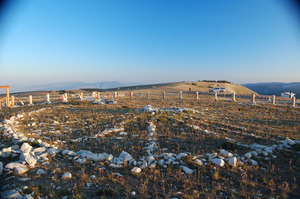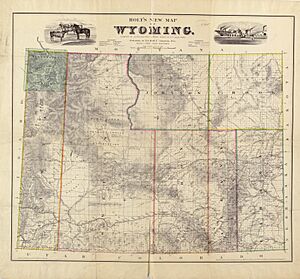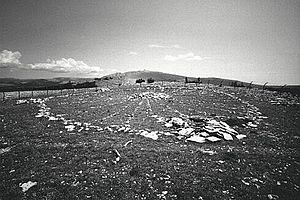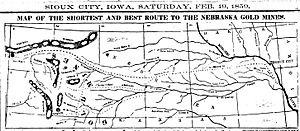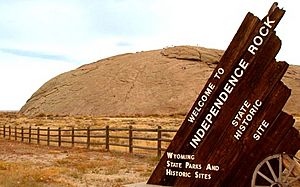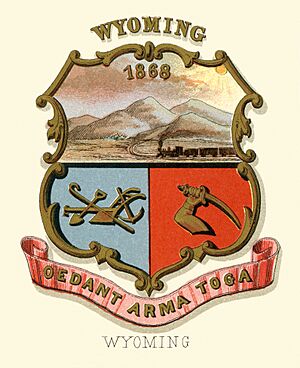History of Wyoming facts for kids
The land we now call Wyoming has been home to people for a very long time, about 13,000 years! Ancient tools like stone projectile points from early cultures such as the Clovis and Folsom people have been found here. In what is now Yellowstone National Park, there's proof that people traded goods across the continent about 1,000 years ago.
The Union Pacific Railroad was very important in bringing European settlers to this area. Wyoming became a U.S. territory in 1868. It was the first place in the U.S. to give women the right to vote in 1869, even though it was still a territory then. Wyoming officially became the 44th U.S. state on July 10, 1890.
Contents
Early Explorers and Mountain Men
People might have explored northern Wyoming in the late 1700s. But John Colter, who was part of the famous Lewis and Clark Expedition, was likely the first white American to enter the region in 1807. He told stories about hot springs and geysers in the Yellowstone area. At first, people thought his stories were made up!
In 1812, Robert Stuart and his group found South Pass. This was an important route that the Oregon Trail later followed. In 1850, Jim Bridger found Bridger Pass. This pass was later used by the Union Pacific Railroad and today by Interstate 80. Bridger also explored Yellowstone, and like Colter, his amazing reports were hard for people to believe.
In the early 1800s, many fur trappers, called mountain men, came to western Wyoming. They were looking for beaver furs. The first "rendezvous" (a big gathering for mountain men) happened in Wyoming in 1824. These gatherings continued every year until 1840, mostly in Wyoming.
Famous Trails and Journeys
The path that became known as the Oregon Trail was used by traders and explorers as early as the 1830s. This trail winds across Wyoming. It enters the state near Torrington and follows the North Platte River to Casper. Then, it crosses South Pass and leaves Wyoming near Cokeville.
In 1847, Mormon pioneers created the Mormon Trail. This trail followed the Oregon Trail but then went south from South Pass to Fort Bridger and into Utah. Between 1840 and 1859, over 350,000 people traveled these trails to places like Utah, California, and Oregon.
In 1859, gold was found in Montana. This led miners to travel north on the Bozeman Trail and Bridger Trail. These trails went through the Powder River Country and Big Horn Basin in Wyoming.
Conflicts and Treaties
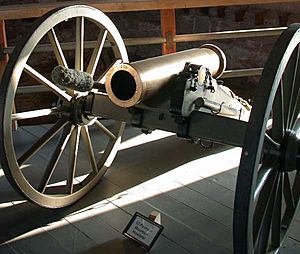
As more settlers came to Wyoming, there were more meetings, and sometimes conflicts, with Native American tribes. The military built posts like Fort Laramie to keep order. In 1851, the first Treaty of Fort Laramie was signed. This treaty aimed to bring peace and keep settlers safe on the trails.
The 1850s were mostly peaceful. However, settlers began moving onto lands that had been promised to the tribes. This caused new problems. Tensions grew, especially after the Bozeman Trail was created in 1864. This trail went through the hunting grounds of the Powder River Country, which was protected by the 1851 treaty.
In 1865, fighting increased. Major General Grenville M. Dodge sent an expedition to try and stop the violence. This led to a battle against the Arapaho tribe. The next year, the fighting grew into Red Cloud's War. This was a major conflict between the United States and the Native American tribes in Wyoming. The second Treaty of Fort Laramie in 1868 ended this war. It closed the Powder River Country to white settlers.
Later, miners broke this treaty by going into the Black Hills. This led to the Black Hills War in 1876. This war was mostly fought near the border of Wyoming and Montana.
The Cattle Industry
In 1866, Nelson Story, Sr. led about 1,000 Texas Longhorn cattle from Texas to Montana. This was the first big cattle drive through Wyoming on the Bozeman Trail.
The Wyoming Stock Growers Association was formed in 1873. This group helped organize the cattle industry in Wyoming. It quickly became very powerful, almost like the government of the territory. It had a lot of influence across the Western United States. This association is still active today.
It is most famous for its role in the Johnson County War in 1892. This conflict, also called the War on Powder River, happened in Johnson, Natrona, and Converse County. It was a fight between smaller ranchers and larger, more established ranchers. The conflict ended with a long shootout. The United States Cavalry had to step in, ordered by President Benjamin Harrison. This event has become a famous story of the Wild West. It has inspired many novels, movies, and TV shows.
Becoming a Territory and State
The name "Wyoming" became popular from a poem written in 1809 called Gertrude of Wyoming by Thomas Campbell. The name comes from a Native American word, xwé:wamənk. It means "at the big river flat" and was first used for a valley in Pennsylvania.
After the railroad arrived, the population of the Wyoming Territory started to grow. The territory was officially created on July 25, 1868. Unlike Colorado, Wyoming did not have a sudden population boom from big gold or silver discoveries in the 1800s.
When Wyoming was writing its constitution, there was a debate about including women's right to vote. But in the end, it was accepted! The constitution also made all water in Wyoming property of the state. Wyoming became the 44th state on July 10, 1890. It overcame challenges like having a small population and being the only territory to give women the right to vote.
Women's Rights in Wyoming
Wyoming territory was a leader in women's rights. In 1869, it gave women the right to vote. This was a huge step! Wyoming also had many other "firsts" for women in U.S. politics:
- In 1870, women served on a jury for the first time in Laramie.
- Mary Atkinson became the first female court bailiff in Laramie in 1870.
- Esther Hobart Morris became the first female justice of the peace in the country in South Pass City in 1870.
- Wyoming was the first state to elect a female governor, Nellie Tayloe Ross. She was elected in 1924 and started her term in January 1925.
Yellowstone National Park and Other Natural Wonders
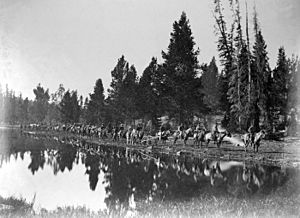
After the amazing reports from explorers like Colter and Bridger, several expeditions explored northwestern Wyoming. The Cook–Folsom–Peterson Expedition in 1869 and the Washburn-Langford-Doane Expedition in 1870 confirmed the mountain men's stories.
In 1871, Ferdinand Vandeveer Hayden led a detailed geological survey of the area. His findings convinced Congress to protect the region. In 1872, Yellowstone National Park became the world's first National Park! The U.S. Army managed the park from 1886 until 1917. Then, the new National Park Service took over. Many historic buildings are protected in the park, and over 1,000 ancient sites have been studied. Most of Yellowstone National Park is in Wyoming.
Wyoming is also home to the nation's first national monument, Devils Tower, created in 1906. And it has the first national forest, Shoshone National Forest, created in 1891.
New Settlers and Challenges
The Homestead Act of 1862 encouraged many new farmers and ranchers to come to Wyoming. They often settled along the fertile riverbanks. In the late 1800s, much of Wyoming's land was public. This meant it was open for homesteading (claiming land to farm) and for cattle to graze freely.
As more individual ranchers moved in, they sometimes clashed with larger ranches over land and water. This led to the Johnson County War in April 1892. This armed conflict was between large cattle owners and smaller ranchers and homesteaders.
More settlers also brought merchants and even outlaws. Famous outlaws like Butch Cassidy and Harry Longabaugh started their criminal careers in Wyoming. They were even jailed there when they were young. A remote area in Johnson County, Wyoming called the Hole-in-the-Wall was a well-known hideout for outlaw gangs from the 1860s into the early 1900s.
Mining in Wyoming
Wyoming didn't have huge amounts of gold or silver, though a small gold rush happened near South Pass in the 1860s. However, coal was found early and has been mined a lot throughout the state. The Union Pacific Railroad ran several coal mines to power its trains. In 1885, problems at a Union Pacific mine in Rock Springs led to the Rock Springs Massacre. This was a major race riot in U.S. history.
Oil is also plentiful in Wyoming. In 1924, there was a scandal called the Teapot Dome Scandal. It involved problems with how oil reserves near Casper were managed. Natural gas, bentonite, and uranium have also been mined in Wyoming over the years.
One important exception for metals was the copper mines in Carbon County, west of Encampment. The Ferris-Haggarty Mine Site provided copper for the world's growing need for electricity in the late 1800s and early 1900s.
Images for kids
-
A 12 pounder mountain howitzer on display at Fort Laramie in eastern Wyoming.
-
The Hayden expedition in Wyoming as photographed by William Henry Jackson


